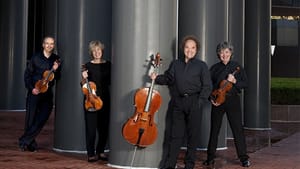Stay in the Loop
BSR publishes on a weekly schedule, with an email newsletter every Wednesday and Thursday morning. There’s no paywall, and subscribing is always free.
Dwelling with the angels
The Takács Quartet performs at Perelman

The Takács Quartet has been one of the best in the business since its formation in 1975 by four students at the Franz Liszt Academy in Budapest. Two of them, second violinst Károly Schranz and cellist Andráz Fejér, remain with the group. Fejér in particular is an amazing musician, whose lines stand out in any passage though he never forces them in the slightest. First British violinist Edward Dusinberre came aboard in 1993, and then American violist Geraldine Walther in 2005, so the Takács is now a truly international ensemble.
Shostakovich and Beethoven are frequently paired, as they were in the Takács’s performance at the Perelman Theater. The two substantial works on offer, the Shostakovich Second Quartet and the Beethoven 15th, would easily have filled an ordinary evening, but the quartet separated them with two works by Anton Webern, the Six Bagatelles, Op. 9 (1913) and the Five Pieces, Op. 5 (1909). The Webern performances were preceded by commentary from Mr. Dusinberre, who observed that Webern’s unique sound world not only influenced much of 20th-century music but also reflected back on Beethoven himself, the differences in style and personality notwithstanding.
Shostakovich's Second Quartet (1944) is rarely performed, though it represents a quantum leap from the First Quartet (1938) — more than twice its length, and with vastly greater technical and emotional range and complexity. The first and last movements have spacious, striding principal themes, and it is in the climax of the latter than one can feel, perhaps, the imprint of the war.
The core of the work, though, is its slow movement, an adagio that begins with a prolonged recitative for the first violin that, deeply inward in feeling, looks forward to the long cadenzas of the first violin and cello concertos, as well as to the composer’s late practice of highlighting single instruments in the quartet ensemble. Dusinberre played it with exemplary sensitivity, and the same might be said of the Takács’s performance as a whole. This was a less symphonic reading of the score than in the classic performances of the Beethoven and Borodin Quartets, or the Emerson Quartet’s in recent times, and one missed a little of the roughness and vigor that are part of the music. On its own terms, however, there was nothing to be faulted, and no lack of projection when needed.
Webernian brevity
In contrast to Shostakovich’s long lines, the Webern pieces — one only 13 bars long — are models of compression. Reacting against Romantic excess, Webern placed maximum weight on each note, rarely using the strings in unison and varying his dynamics from bar to bar. Yet, as Dusinberre reminded us, he was a great admirer of Mahler, from whose own quicksilver changes of mood he learned much, and in the Takács’s performance, one heard a sensibility that’s still deeply, not to say exacerbatedly, Romantic. (Webern, stung by criticisms of his brevity, finally decided to compose a full-blown symphony, whose length he estimated at half an hour. To his chagrin, it timed out when played at nine minutes.)
Beethoven composed his A minor Quartet in Baden, where he went in the spring of 1825 to recuperate from a serious intestinal inflammation. Not much is known about this period, but suffice it to say that he dwelt with the angels. “Sublime” is the only fitting, indeed almost the only possible, description of the quartet, and in the ethereality of its opening bars I did indeed hear a startling echo of the Webern music just played, as if the latter were the earlier work. Even among the late quartets, the A minor is unique, and the central adagio is one of the summits of Western art. To be sure, there is boisterousness and jocosity too in the quartet, as in almost everything Beethoven wrote, but on another plane: This music occupies a place where suffering and serenity have become almost indistinguishable, almost one.
The Takács played it with an unforced eloquence and authority that served it well. I always live through a performance of music that I cherish fearing a wrong note at a critical moment, but at a certain point in this one it crossed my mind that not only had there been not the slightest blemish but that there would be none, so secure were the performers in their art and so united in their purpose. You can’t, my friends, be in a better place than that.
What, When, Where
The Philadelphia Chamber Music Society: The Takács Quartet. Dmitri Shostakovich, Quartet No. 2, Op. 68; Anton Webern, Six Bagatelles, Op. 9 and Five Pieces, Op. 5; Ludwig van Beethoven, Quartet No. 15 in A minor, Op. 132. At the Perelman Theater, Broad and Spruce Streets, Philadelphia. April 9, 2014. 215-569-8080 or www.pcmsconcerts.org.
Sign up for our newsletter
All of the week's new articles, all in one place. Sign up for the free weekly BSR newsletters, and don't miss a conversation.

 Robert Zaller
Robert Zaller